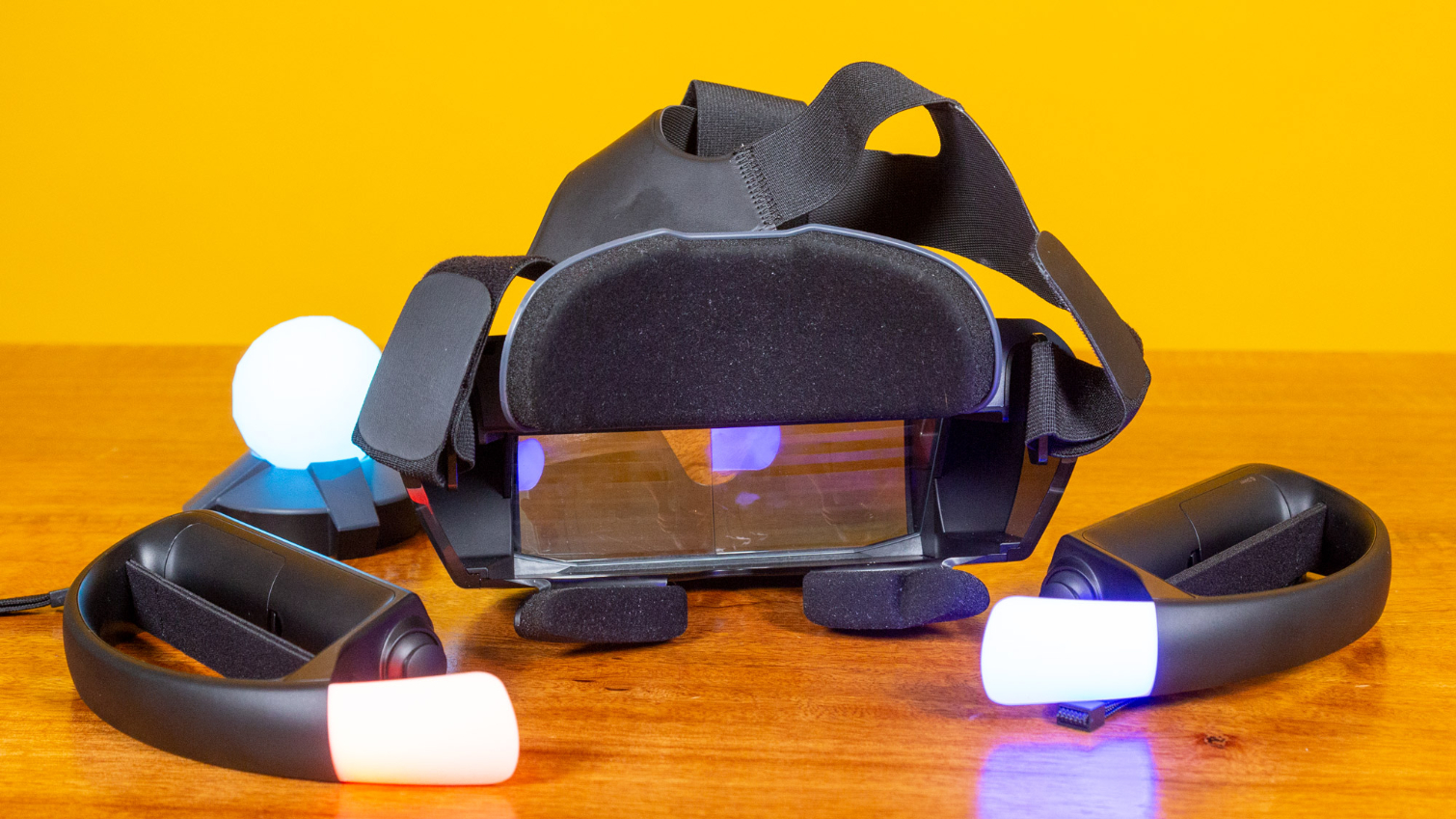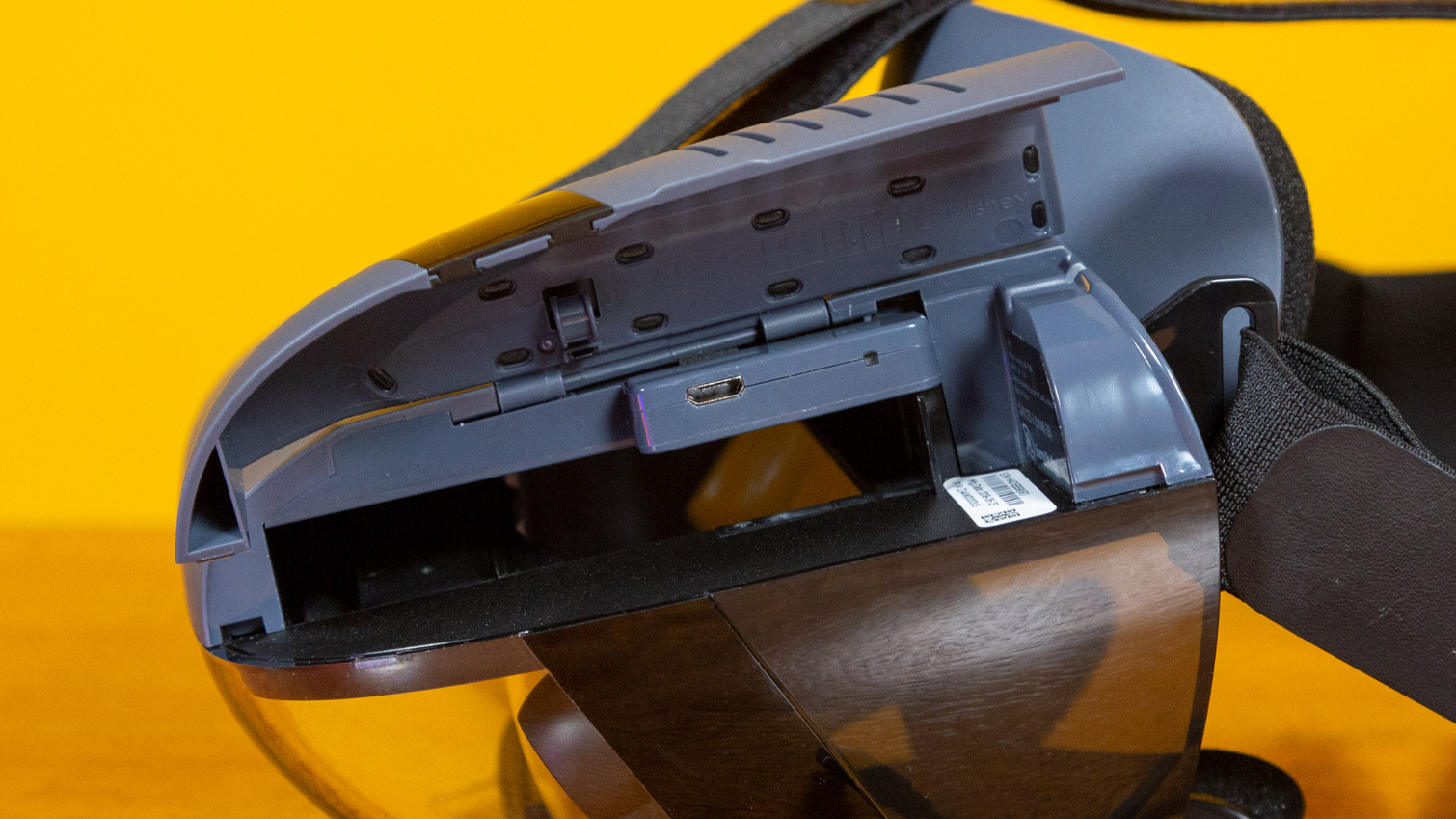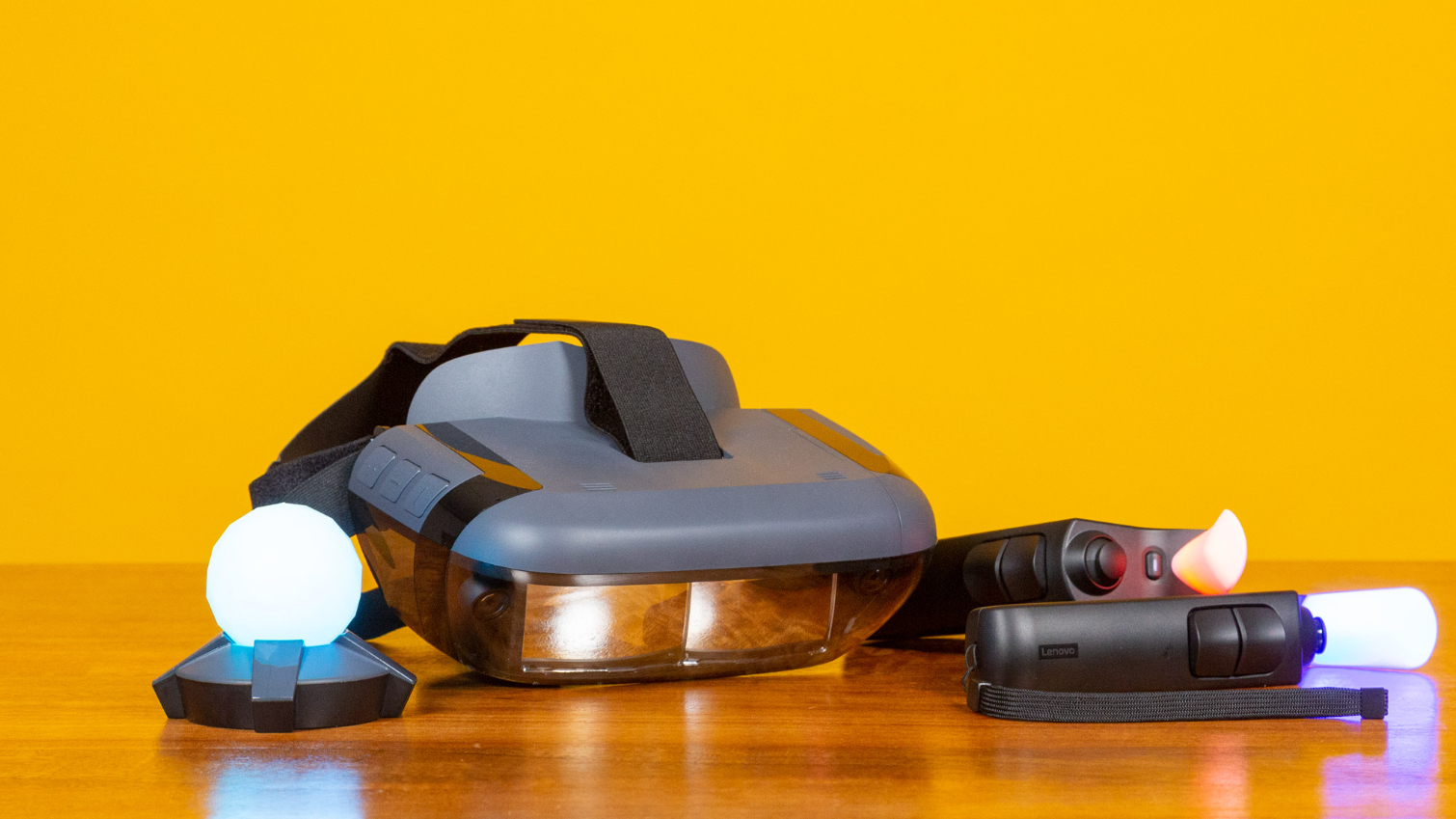Tom's Hardware Verdict
The Lenovo Mirage AR headset is much more tempting with the character-loaded Marvel Dimension of Heroes game and new Universal Controllers. But it needs more apps and improved comfort to be the hero AR gaming needs.
Pros
- +
Good image quality
- +
Good battery life
- +
Fun Marvel game with six characters
Cons
- -
Sometimes uncomfortable
- -
Occasional smartphone connectivity issues
- -
Expensive for a product with two apps
- -
Marvel game’s 2P mode requires two headsets
Why you can trust Tom's Hardware
Augmented reality (AR) is one of the most attainable forms of XR (Extended Reality). Unlike virtual reality (VR) headsets, many of which require PC connectivity, base stations or hundreds of dollars, running AR apps can be as simple as pointing a smartphone camera at something and seeing information, games and more virtually layered on top.
The Lenovo Mirage AR headset is an attempt to bring AR gaming into the mainstream. At this stage, it’s a one-of-a-kind product, letting you slide in a smartphone to run one of two free AR games: Marvel Dimension of Heroes or Star Wars: Jedi Challenges. These are colorful, interactive full-fledged games with enough characters and levels for hours of fun.
But for $250, we demand more apps, no matter how fun the current ones may be. It’s possible the headset could get more games in the future. However, unless Lenovo can also make the headset more universally comfortable, another well-timed franchise won’t save the day.
Lenovo Mirage AR Specs
| Headset | |
| Battery | 2200mAh Li-Po |
| Ports | 1x Micro-USB |
| Dimensions (W x H x D) | 8.2 x 3.3 x 6.1 inches (209.2 x 83.4 x 154.8mm) |
| Weight | 1.05 pounds (477g) |
| Warranty | 1 Year |
| Tracking Beacon | |
| Battery | 2x AA |
| Dimensions | 3.7 x 3 inches (94.1 x 76.7mm) |
| Weight | 0.3 pounds (113.5g) |
Design and Comfort



XR headsets still have a long way to go before being lightweight or, shall we say, ‘normal looking.’ Some -- like the sunglass-mimicking Nreal Light or North Focals smart glasses -- attempt to look more mainstream. However, the Mirage AR leans fully into its futuristic weirdness, with its mirror-y lenses and three-point fabric and Velcro head strap locking you in.
Sitting alongside the headset’s concave lenses, which look like mirror panels, are two fisheye camera sensors for inside-out positional tracking. The sensors track the lights emitted from the tracking beacon and controllers, and the headset processes this data and sends it to the app to display on the smartphone. On the right side of the headset, framed by some black, reflective plastic, are three buttons with vague markings to denote select, GIF capturing and menu.
On the side is a hidden panel with a well-placed vent. The panel opens up accessing the tray where you put your smartphone. The idea of figuring out how to integrate your phone into this headgear and turning it into an AR gaming machine may be daunting for the many people new to AR headsets. However, Lenovo surprisingly makes this very clear, with included printout instructions and picture instructions engraved into the removable plastic tray, which, of course, will always be on hand (unlike that paper manual).
The plastic smartphone tray is worryingly flimsy with its notches and thin build. There’s little wiggle room, especially for fitting in larger phones, like the Google Pixel XL (5.5-inch screen). Different notches and sliders let you equip phones with screens 4.7 inches and larger, and the Marvel app will either detect your phone model, let you select your model or let you enter a custom phone size.
Get Tom's Hardware's best news and in-depth reviews, straight to your inbox.
The Mirage AR headset supports a myriad of smartphones with three included adapter cables (Micro USB, USB-C and Lightning) for different types of smartphones. The cables are so tiny, though, that resetting the Marvel app, which I found myself needing to do repeatedly, means untethering your phone, taking out the tray and, likely, removing the smartphone from the tray to access options on the screen. If only the cables were longer, you could use your phone while keeping it connected to the headset.
A handy, tiny red light inside the panel indicates if the smartphone is successfully tethered to the headset. However, various times while using a Samsung Galaxy S10 and Google Pixel XL, I either couldn’t get the light to light up for me, or it would, but the phone would still say the headset wasn’t connected. I would have to reset the app several times to get it working.
The Tracking Beacon is a burst of delight emitting a brilliant shade of cyan or magenta -- your choice; it has no impact on the game. It’s shaped like a golf ball but squishy and is the cutest base station I’ve ever seen. Unfortunately, you’ll have to keep feeding it AA batteries over time and can’t charge it.
The Mirage AR headset isn’t remarkably heavy. At 1.05 pounds (0.48kg) it’s lighter than the Oculus Quest standalone VR headset (1.2 pounds / 0.5kg). But don’t forget to factor in the weight of your phone. With a Galaxy S10 tethered, the total weight became 1.35 pounds (0.61kg), and with a Pixel XL I was carrying 1.45 pounds (0.66kg) on my face. At this point we’ve slightly surpassed the Quest’s weight. But the difference is small, so that’s likely not the only thing that makes this headset feel like an oncoming headache.
The Mirage AR has cushions for the forehead and beneath your two eyes, but they’re flimsy and don’t give off an air of comfort. The foam is very thin and looks easy to rip, and there’s a thin felt-like material on top that’s far from feeling luxurious. I must’ve had something resting into one of the eye cushions at one point, as there’s a small vertical indentation there. So it seems the cushions can easily, and seemingly permanently, be marred.
With the weight and cushions offering minimal support, I typically found myself wanting to cut playtime short. While wearing glasses, I adjusted it immensely -- the headset has two Velcro straps by each ear and another extending from the visor and across the head. But it always felt heavy and like it was squeezing my skull from the sides and by my eyes. At the least painful adjustment, it felt too high under my eyes, with the eye cushions noticeable and distracting. The headset does stay firmly in place, however.
You can still see while wearing the Mirage AR, which is handy for speaking to someone quickly or making sure you’re still in the play area. Lenovo recommends there be a 4-5.2-feet radius of clear space circling the tracking beacon.
Universal Controllers
| Battery | 2x AA |
| Connectivity | Bluetooth 4.2 |
| Dimensions | 7.8 x 3.4 x 1.4 inches (197.3 x 87.5 x 35.2mm) |
| Weight | 0.3 pounds (130g) |
Marvel Dimension of Heroes is one of two games available for the Mirage AR. The headset first debuted with Star Wars: Jedi Challenges and appropriately themed Lightsaber controllers. The release of Marvel Dimension of Heroes came alongside new controllers for the Mirage AR headset, dubbed Universal Controllers. The lightweight, comfortable and easy-to-use controllers are also compatible with Jedi Challenges.
The Universal Controllers’ employ a simple design. Each requires two AA batteries, which you pack into the back of the controllers, adding some central weight. Each controller has a stretchy strap that ensures the controllers stays attached to you while making all types of hand gestures, including open-handed ones.
The joystick up top aligned nicely with my thumb and shows quick responsiveness, snapping back to its center point after I flicked it in either of four directions (you can also press it in). The two large control buttons feel of basic, plastic quality. They also lined up well with my ring and middle fingers’ top knuckles. I wish the buttons fell closer to my fingertips, but this will depend on the size of the users’ hand and fingers. Regardless, I had no problem working the buttons or memorizing the controls.
A power button is well-located by the can’t-miss LED tracking light (right is red, and left is blue, evoking Nintendo Switch comparisons), so you shouldn’t find yourself accidentally hitting it and abruptly turning the controller off.
Image Quality
The Mirage AR projects the game through optics. The smartphone outputs the image, which goes through a polarization layer before traveling through a beam splitter. That splitter projects the picture out and onto the concave lenses for viewing with a 60-degree horizontal field of view (FOV) and 30-degree vertical FOV. Because of this, Lenovo says screen protectors may hurt brightness, but I still enjoyed playing with mine on just the same.
Whether at night or in a room flooded with sunlight, the Mirage AR displayed Marvel’s heroes and villains clearly and with bright colors. The darker the room, the bolder the image, but even in a bright room, the game was completely playable, and colors -- from Doctor’s Strange orange, flowing cape to Ronan the Accuser's purple skin -- were apparent, if not vibrant.
I tried getting my superhero on under various lighting conditions, including in the middle of a very sunny day with the blinds down (a bit of light still peeked through). The room wasn’t pitch black, yet the picture was clear and colorful but didn’t have the same saturated color I enjoyed at night or in a truly dark room. The AR layered easily upon my wall. The wall had a desk with decorations above it and a doorframe, but none of that distracted from the strength of the image. With the blinds open, darker clothes were faded, but yellows, like the game’s text, were still legible and Doctor Strange’s colors were strong. However, a friend who tried it reported double vision when playing with some sunlight (it went away when playing in the dark). You’ll want to darken your space as much as possible.
Marvel Dimension of Heroes Gameplay
Lenovo recommends that there be a 4.9-8.2-feet radius of clear space around the tracking beacon during gameplay. And it means it. At one point, I had an ample 8.2 feet of distance between me and the beacon, but countertops were within 4 feet of the beacon. Assumedly due to those interferences, the AR started display higher and higher up my wall, to the point where Doctor Strange was hovering above me. By the time I exited to the menu, the hero was on the ceiling. So you’ll want to make sure you have a completely empty space all around the beacon at the distance specified for proper tracking.
With open space, the headset tracked much better, with the game displayed perpendicular to the tracking beacon and it staying in a consistent, visible location.
One of Marvel Dimensions of Heroes’ strengths is the character lineup. With individual tutorials for Captain America, Thor, Black Panther, Star-Lord, Captain Marvel and Doctor Strange (sorry, Hulk fans), there’s a lot to do.
Of course, each Avenger has their own set of moves, requiring unique gestures with the controllers, like holding multiple buttons down, slashing, punching and stretching both arms out. Large AR instructions make learning moves easy, but some controls are more intuitive than others. For example, for one of Captain Marvel’s moves, you hold down your pointer finger for an open-hand photon beam. On the other hand, the controllers were accurate, so when I was Star-Lord I was able to shoot straight. And remember that tracking space we mentioned? It’s also important for bobbing and weaving necessary for avoiding getting hit. HP damage.
The game has three different modes. In Story Mode, you face villains including Ronan, Loki, Ultron Prime and Winter Soldier in an effort to thwart an attack on Earth. Survival mode challenges you to survive as long as possible as one of the Avengers.
Any game is more fun with a friend, and Marvel Dimension of Heroes does have a 2P mode. However, you’ll have to convince another person to buy the $250 kit and come over to play with you. Room space requirements remain the same. That means a total of $500 has to be shelled out in order to play this Marvel game with another person. If you do manage that, you two can stand-by-side and compete to kill the most enemies. However, your team must be either Thor and Captain America or Black Panther and Doctor Strange. Apparently, the Avengers have a teamwork issue as no other pairings are possible, and Captain Marvel and Star-Lord are benched.
Battery Life
The Mirage AR charges via the included MicroUSB to Type-A cable and included wall adapter. The LED light inside the headset’s panel clues you in, blinking when power’s off and on fully when it’s charging.
Lenovo claims the headset lasts up to 5 hours. However, I had the headset on, including setup and troubleshooting time, for 8 hours before it died. But don’t forget that the controllers and tracking beacon also require AA batteries. While Marvel Dimension of Heroes doesn’t feature a way to check the Tracking Beacon’s battery status, my Universal Controllers still had 92% battery after about 3 hours of gameplay.
Bottom Line
The Lenovo Mirage AR headset is even better with the addition of Marvel Dimension of Heroes. The game means the headset now has two compatible games, including a superhero-packed one with multiple well-known characters and villains and distinct moves for hours of fun. Additionally, the new Universal Controllers offer a quality experience with easy controls and navigation with a variety of hand gestures.
However, the headset isn’t universally comfortable. Experience will likely differ, but I often found myself fearing an oncoming headache or distracted by the eye cushions.
That said, the Mirage AR is one-of-a-kind. No other device offers this level of AR gaming, and the fact that it does so with popular franchises like Avengers and Star Wars means that there are games you might actually want to play. We’d love to wait until the Mirage AR potentially gets more games or apps before spending $250. However, with its cutting-edge approach to AR gaming, you can’t find anything else right now like the Mirage AR.
Image Credits: Tom's Hardware
MORE: Best Virtual Reality Headsets
MORE: All Virtual Reality Content
MORE: Virtual Reality Basics

Scharon Harding has over a decade of experience reporting on technology with a special affinity for gaming peripherals (especially monitors), laptops, and virtual reality. Previously, she covered business technology, including hardware, software, cyber security, cloud, and other IT happenings, at Channelnomics, with bylines at CRN UK.



